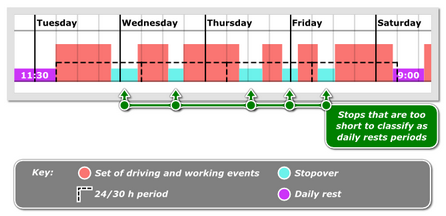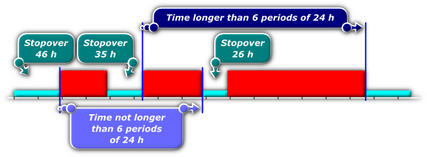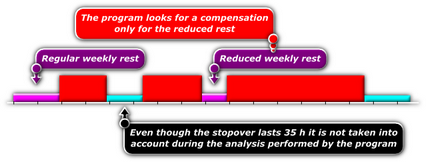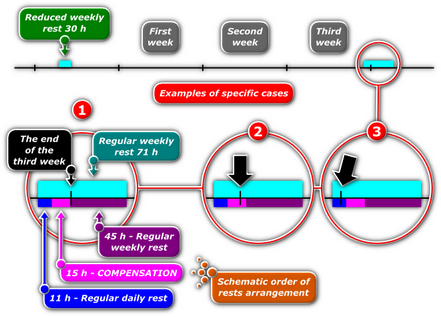The program closes the daily driving period if the daily rest period lasts at least (select the correct option):
•7 hours; •9 hours; |
|

|
Option checked - if the driver does not use the daily rest period of at least 9 hours, according to guideline No. 7 to the European Commission (Social legislation in road transport, Regulation (EC) No 561/2006, Directive 2006/22/EC, Regulation (EU) No 165/2014) the program sets fixed periods of 24 or 30 hours and in each of them is looking for infringement of shortening the daily rest period;

If during the analyzed period of 30 hours all the activities (depending on settings) are in a team, the program sets a period of 30 hours; in other cases 24-hour period is adopted.
Options in the Multi-manning frame ("TachoScan -> Infringements - Tolerance" tab of the program "settings" window) impact determining the activities in a team.
If during the 24/30 hour period there are several stops, the analysis takes into account the longest stop.
|
|
|

|
Option unchecked - analysis of the next 24/30 hour period begins at the end of the daily / weekly rest.
|
|
|
In a situation where within 2 weeks there are 5 exceedances of the daily driving time over 9 hours, where two exceedances take place in the first week, next 2 are in the second week, and fifth at the turn of those weeks, the program:

|
Option checked - does not show an offense;
|

|
Option unchecked - shows an offense.
|
This option applies to Article 6 paragraph 1 of Regulation 561/2006:
1. Daily driving time shall not exceed 9 hours.
However, the daily driving time may be extended to at most 10 hours not more than twice during the week.
|
|
|
|
By default, activation of the point for both norms, saying that the rest time during continuous driving cannot be included into the rest time during daily drive, is turned off and this applies to the daily rest time "consisting" of 2 or 3 fragments. In other words, the rest time during the drive being, e.g. 1h is the rest time for both daily and continuous drive. In order to change this, deactivate this option.
This option applies only to the analysis of AETR infringements.
|
|
|
|
Art. 7 AETR: Breaks: "After driving for four and half an hour the driver has to comply with the break lasting at least forty five minutes, unless he starts the rest time". If this option is marked, when checking for violations, the program can treat availability as a break.
|
|

|
Option checked - the program will close the continuous period of driving time after every 45 min. of stop.
|

|
Option unchecked - the program will sum up (in terms of Regulation No. 561/2006) and optimize the continuous driving time in such a way, as to generate as little infringements as possible.
|
Regular or reduced daily rest period closes continuous driving time, regardless of this option.
|
|
|
|
An exemplary week:


|
Option checked - TachoScan chooses - from among all rests lasting between 24 h and 45 h in the two-week period - the minimum number of rests so as to maintain adherence to the law (and in particular to the requirement that no more than 6 days /periods of 24 h/ may pass between the preceding and the successive weekly rests), and looks for a compensation for them.
After the interpretation is accomplished by the program:

|

|
Option unchecked - During the analysis, the program chooses - from among all rests lasting between 24 h and 45 h in the two-week period - the one that is optimal, and looks for compensation only for this single rest. The remaining reduced weekly rests need no compensation.
After the interpretation is accomplished by the program:

|
|
|
This option operates similarly to the above one, the only difference being that the program requires compensation for only such weekly rests that meet the requirement of starting the weekly rest period within 6 periods of 24 hours.
|
|


|
Option checked - Program requires the compensation to be taken in full before the end of the third week following the reduction.
In the situation as presented on the figure above the program will insert compensation only in the first case – this is an extreme example in which the end of the compensation being inserted coincides precisely with the end of the third week following the reduced weekly rest;
|

|
Option unchecked - Program requires the rest which includes compensation to start before the end of the third week following the reduced weekly rest.
In the situation as presented on the figure above the program will insert compensation in each case. The second and third cases show that whatever is the location of the rest for compensation, the program will always insert the compensation, provided the weekly rest begins before the end of the third week following the reduced weekly rest.
|
|
|
The program treats driving event checked as OUT as "other work".
Drivers of vehicles equipped with digital tachograph can label driving times as OUT - those activities are excluded form the regime of the Regulation (EC) No. 561/2006.
|
|
|
|
This option is used to specify how many weeks before you want to start the analysis of infringements.
|
|

|
Option checked - drivers, with self-employment / civil-law agreement option selected in the add/edit drivers window, are checked;
Options: Show transgressions of average weekly working time, Show transgressions of weekly working time, Show transgressions of working time of at most 10 hours at night time are active only for self-employed drivers.
|
|
|

|
Option unchecked - all drivers are checked;
Options: Show transgressions of average weekly working time, Show transgressions of weekly working time, Show transgressions of working time of at most 10 hours at night time are active for all drivers.
|
|
|
|
|
When you select this option, the program checks whether the average weekly working time of a driver does not exceed 48 hours.
|
|
You can set any period which is to be analyzed by the program - after pressing  program automatically determines the periods from the specified day to the current day. program automatically determines the periods from the specified day to the current day.
|
|
When selected, the program checks whether the driver's working time per week does not exceed 60 hours;
|
|
When selected, the program checks if in the day and night periods when the driver worked at night, during the 24 hours from the start of day and night period, working time was maximum 10h.
|
|
Program checks if the driver did not exceed the uninterrupted working time limit.
|
|
Daily rest on the ferry cannot be shortened.
It is permitted to divide the regular rest on the ferry into 3h and 9h.
|
|
The analysis was illustrated on the example of the day:
 Fig. An example of the day on which the regular daily rest on the ferry was taken too late. Depending on the option selected below the analysis result shall be as follows:
reduced rest
The program assumes the shortened daily rest time standard.
 Fig. reduced rest - the analysis result. too short rest infringement
The program requires regular daily rest time (11h).
 Fig. too short rest infringement - the analysis result. |
|
The mechanism of the option was illustrated in the following example:


|
Option checked - the program, as the option name suggests, begins the analysis of rest periods from the marker of the end country and ends it at the marker of the start country. In the case, when the country marker is "inside" of the activity (e.g.: end country marker - Fig. bellow), the program includes the whole event in the analysis.

|

|
Option unchecked - during the analysis, the program assumed the stop at 2:07, driving period as the first rest break, the second stop at 0:39, another driving period as the second rest break and a stop at 8:05. The sum of stops is less than 11h (2:07 + 0:39 + 8:05 = 10:51) - in this case, the program adopted 8:05 as the longest daily rest and thus displayed an infringement.

|
Selecting this option, can improve the analysis of rest periods while on a ferry - it depends on the correct entry of the start country and end country.
If the country start and end markers are entered incorrectly, we recommend unchecking this option.
|
|
|
|
|
|